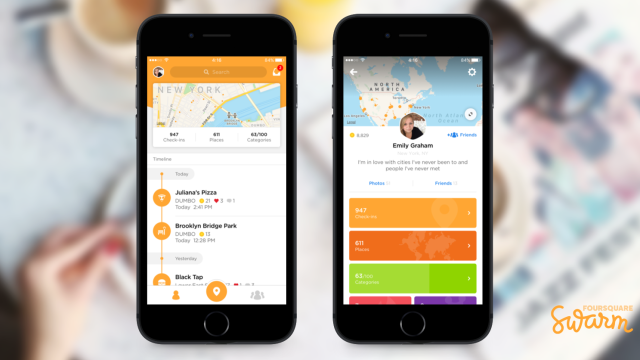Android/iOS: Foursquare’s Swarm 5.0, released earlier this week on iOS and Android, has a cleaner look and better venue categorisation. Most importantly, it downplays most of the social check-in app’s social elements and strengthens its solo benefits. That’s great news, because Swarm might be more useful if you use it alone.
Photo by Foursquare
The early promise of Foursquare (and its predecessor Dodgeball) was to help people meet up with their friends by selectively sharing their location. This would give people a sort of social radar that let them meet up ad hoc. Unlike Google Maps or Apple’s Find Friends, Swarm leaves the user in control of each check-in, making it less exhibitionist but also less frictionless.
The idea was tantalising enough for Facebook to enable location check-ins in 2010. But not even Facebook could convince people to report every time they showed up at a bar or restaurant. Instagram, Twitter and Snapchat adopted location tags too, but while this makes for excellent after-the-fact content aggregation, most people don’t use it frequently enough to enable serendipity-based drop-ins.
Swarm’s social elements (such as becoming “mayor” of your favourite venue or collecting points for weekly contests) aren’t that useful unless your friends are fellow diehards. As a longtime diehard (and acquaintance of Foursquare’s founders), I’ve seen fewer and fewer of the early core users check in, while newer friends have never joined. The social panel of the app has become a ghost town populated by people I knew better in 2014.
But that hasn’t discouraged me from checking in (which now often takes just a swipe and a tap from your lock screen). I’m not here for the points or even the casual hangouts; I’m here to keep a journal of where I’ve been, which I end up consulting several times a week.
Foursquare is fairly open about Swarm 5’s shift toward solo features. “For years Swarm focused on helping users connect with friends in the real world,” a Foursquare rep told me.
The common theme, however, was that all users felt that the greatest value in Swarm is that it creates a comprehensive lifelog of everywhere they have been, from the mundane to the extraordinary, that they can share and revisit. This was the focus for Swarm 5.0.
The company still benefits as long as you’re providing it data, which it then sells to advertisers. According to Wired, “ad-targeting and other services allow the company to make money from a relatively small user base.” As usual, the service is free because you’re the product. Or in another sense, you’re the free labour, and the database you’re building is the product. Not a bad trade-off.
Swarm’s main display used to show where your friends had checked in. Now that display shares equal billing with a solo view, displaying a timeline and map of your past check-ins. You can share this map, but more importantly, you can analyse it next time you’re trying to remember what you did Friday night, or returning to your old neighbourhood and wondering what to eat.
Your Swarm check-ins also help Foursquare customise your recommendations, which gives it an edge over Yelp, but you can already customise your recs by answering some questions about your tastes. Check-ins also help your friends see your recommendations, but again, that doesn’t matter if your friends aren’t on it.
That record of where you’ve been is still the killer app. Whenever you’re tired and you just want to go somewhere familiar, just open Foursquare and flick on the “You’ve been” filter. Every now and then, rate your past visits on Foursquare, and you’ll have a list of places you’ve “liked”. Now it will be easy to pick somewhere to meet up or to recommend to a visiting friend. All this takes minimal effort, and doesn’t require carefully curating lists, writing tips, or connecting with all your friends.
And maybe you shouldn’t connect with your friends, even if you can. What will you get from their occasional check-ins, besides FOMO, meaningless likes, and annoying updates about competing for points?

Comments